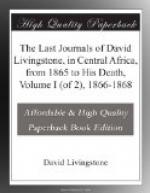Syde told me previously to this event that he had fought the people who killed his elder brother Salem bin Habib, and would continue to fight them till all their country was spoiled and a desolation: there is no forgiveness with Moslems for bloodshed. He killed many, and took many slaves, ivory, and copper: his tusks number over 200, many of large size.
19th and 20th December, 1868.—To Chisabi’s village stockade, on the left bank of the Lofunso, which flows in a marshy valley three miles broad. Eight of Mohamad Bogharib’s slaves fled by night, one with his gun and wife; a, large party went in search, but saw nothing of them.
To-day an elephant was killed, and they sent for the meat, but Chisabi ordered the men to let his meat alone: experience at Kabwabwata said, “Take the gentle course,” so two fathoms of calico and two hoes were sent to propitiate the chief; Chisabi then demanded half the meat and one tusk: the meat was given, but the tusk was mildly refused: he is but a youth, and this is only the act of his counsellors. It was replied that Casembe, Chikumbi, Nsama, Merere, made no demand at all: his counsellors have probably heard of the Portuguese self-imposed law, and wish to introduce it here, but both tusks were secured.
22nd December, 1868.—We crossed the Lofunso River, wading three branches, the first of forty-seven yards, then the river itself, fifty yards, and neck deep to men and women of ordinary size. Two were swept away and drowned; other two were rescued by men leaping in and saving them, one of whom was my man Susi. A crocodile bit one person badly, but was struck, and driven off. Two slaves escaped by night; a woman loosed her husband’s yoke from the tree, and got clear off.
24th December, 1868.—Five sick people detain us to-day; some cannot walk from feebleness and purging brought on by sleeping on the damp ground without clothes.
Syde bin Habib reports a peculiar breed of goats in Rua, remarkably short in the legs, so much so, that they cannot travel far; they give much milk, and become very fat, but the meat is indifferent. Gold is found at Katanga in the pool of a waterfall only: it probably comes from the rocks above this. His account of the Lofu, or, as he says, West Lualaba, is identical with that of his cousin, Syde bin Omar; it flows north, but west of Lufira, into the Lake of Kinkonza, so named after the chief. The East Lualaba becomes very large, often as much as six or eight miles broad, with many inhabited islands, the people of which, being safe from invasion, are consequently rapacious and dishonest, and their chiefs, Moenge and Nyamakunda, are equally lawless. A hunter, belonging to Syde, named Kabwebwa, gave much information gleaned during his hunting trips; for instance, the Lufira has nine feeders of large size; and one, the Lekulwe, has also nine feeders; another, the Kisungu, is covered with, “tikatika,” by which the people cross it, though it bends under their weight; he also ascribes the origin of the Lufira and the Lualaba West, or Lofu, with the Liambai to one large earthen mound, which he calls “segulo,” or an anthill!




